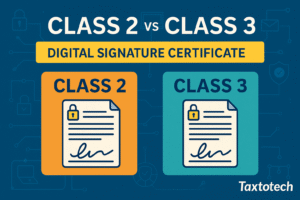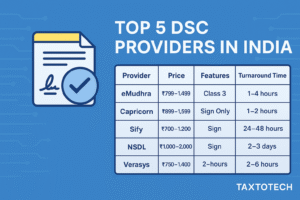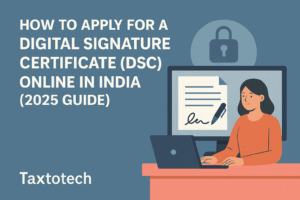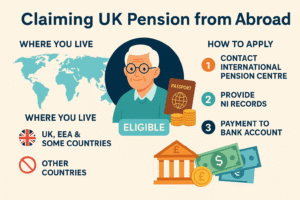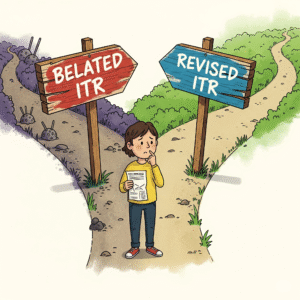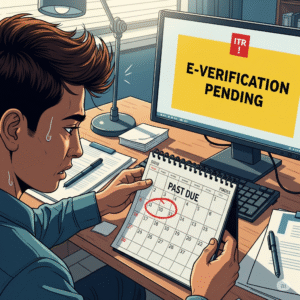You’ve done it. You’ve successfully navigated the complexities of tax filing and submitted your Income Tax Return (ITR) before the July 31st deadline. You breathe a sigh of relief, ready to forget about taxes for another year. But wait… what about that final, crucial e-verification step? It’s a small detail that’s easy to overlook, and many Taxtotech Readers find themselves in this exact situation every year.
Suddenly, panic sets in when you realize you’ve crossed the 30-day window. You’re not alone in asking, “What happens now?” The consequences of a missed ITR e-verification deadline are serious, but the situation is almost always fixable.
But don’t worry. At Taxtotech, we specialize in turning tax anxiety into clear, actionable steps. This comprehensive rescue guide will walk you through exactly what to do to validate your return, protect your refund, and get back on track with the Income Tax Department.
Why E-Verification is Non-Negotiable: The 30-Day Rule Explained
First, let’s understand why this step is so critical. E-verification is the process of electronically signing and confirming that the information submitted in your ITR is authentic and accurate to your knowledge. Without this verification, the Income Tax Department considers your return incomplete.
Under the current rules, you must e-verify your ITR within 30 days of filing it.
What happens if you don’t? The consequence is severe: Your ITR is treated as invalid or non-est, which means the law considers it as if you never filed it at all. This can lead to:
- Inability to process your tax refund.
- Accrual of interest on any tax due.
- Potential penalties for non-filing of return.
- The inability to carry forward any losses to future years.
This is why addressing a missed ITR e-verification deadline is not just important—it’s urgent.
Your First Step: The “Condonation of Delay” Lifeline
If the 30-day window has slammed shut, your primary course of action is to request forgiveness from the Income Tax Department. This is officially known as submitting a “Condonation of Delay in Verification” request.
In simple terms, you are formally asking the tax department to excuse your delay and grant you a second chance to verify your return. You must provide a genuine reason for the delay. The portal provides a dropdown menu with several options, such as:
- I was not aware of the e-verification procedure.
- My ITR was filed by a tax professional who did not inform me.
- Technical issues with the e-filing portal.
- Personal reasons like a medical emergency.
Choose the reason that is most applicable to your situation. In most genuine cases, the department approves these requests, allowing you to proceed with verification.
Step-by-Step Guide: How to Verify Your ITR After the Due Date
Once you are ready to fix the issue, follow these steps precisely on the income tax portal.
Step 1: Log in and Submit Your Condonation Request
- Go to the official Income Tax e-filing portal:
www.incometax.gov.in - Log in to your account using your PAN as the User ID and your password.
- Navigate to your Dashboard. Click on ‘Services’ -> ‘Condonation Request’.
- On the Condonation Request screen, select the option ‘Delay in e-Verification’.
- A new screen will appear showing the pending return that requires verification. Click ‘Continue’.
- Select the reason for your delay from the dropdown menu. Click ‘Submit’.
- A success message will appear, confirming your request has been submitted. You will typically receive an email confirmation as well.
Step 2: E-Verify Your Return Using Your Preferred Method
After your condonation request is approved (which is often instant), you can immediately proceed to e-verify. Here are the most popular and convenient methods.
| E-Verification Method | What You Need | How It Works (Simple Steps) |
|---|---|---|
| Aadhaar OTP | Aadhaar linked with your PAN and a mobile number linked with Aadhaar. | 1. Select ‘Aadhaar OTP’. \ 2. An OTP is sent to your Aadhaar-registered mobile. \ 3. Enter the OTP to verify instantly. |
| Net Banking | An active net banking account with a bank that provides this facility. | 1. Log in to your net banking portal. \ 2. Find the ‘Income Tax e-Filing’ link. \ 3. You’ll be redirected to the tax portal and can verify with one click. |
| Bank Account EVC | A pre-validated bank account on the e-filing portal. | 1. Select ‘Bank Account EVC’. \ 2. An Electronic Verification Code (EVC) is sent to your registered mobile and email. \ 3. Enter the EVC to verify. |
| Demat Account EVC | A pre-validated Demat account on the e-filing portal. | 1. Select ‘Demat Account EVC’. \ 2. An EVC is sent to your registered mobile and email. \ 3. Enter the EVC to verify. |
| Digital Signature Certificate (DSC) | A valid Class 2 or Class 3 DSC. | 1. Select ‘DSC’. \ 2. Attach your DSC USB token and enter the password. \ 3. Your ITR is verified. |
The Offline Method: Sending ITR-V to CPC Bangalore
If none of the online methods work for you, there is always the physical option. You can print your ITR-V (Acknowledgement), sign it, and mail it to the tax department.
Address: Centralised Processing Centre (CPC), Income Tax Department, Bengaluru – 560500, Karnataka, India.
Follow these rules meticulously to avoid rejection.
| Do ✅ | Don’t ❌ |
|---|---|
| Print on a clean, white A4 sheet of paper. | Do not use any other color or size of paper. |
| Sign the form clearly in blue ink only. | Do not use black ink or any other color. |
| Send via Speed Post only. | Do not use regular post or a private courier service. |
| Ensure the barcode and numbers are clear. | Do not staple, tear, or fold the form across the barcode. |
| Mail it within 30 days of filing (or after condonation approval). | Do not send any other documents along with the ITR-V. |
How Taxtotech Prevents These Headaches From Happening
While this guide helps you fix a missed ITR e-verification deadline, the best strategy is always prevention. The stress and uncertainty of post-filing issues can be completely avoided. When you choose to file your taxes with Taxtotech, our intelligent platform and expert services are designed to ensure a flawless process from start to finish.
Our system prompts you for immediate e-verification upon successful filing, and our experts are on hand to guide you through the process. We eliminate the risk of missing crucial deadlines, so you can have true peace of mind. Experience a truly seamless and stress-free tax season by exploring our services at https://taxtotech.com.
Conclusion: From Panic to Peace of Mind
Missing the 30-day ITR verification window is a serious but fixable error. The key is to act quickly, submit a condonation request, and use one of the many available methods to verify your return. By following the steps outlined in this guide, Taxtotech Readers can confidently navigate this challenge and ensure their hard work of filing their return doesn’t go to waste. You now have the knowledge to resolve this common but stressful issue and secure your tax refund.
Call to Action:
Have you ever faced an ITR verification issue or had to submit a condonation request? Share your experience or questions in the comments below to help others in our community!
Frequently Asked Questions (FAQs)
Q1: How do I know if my ITR is successfully verified? A: After successful e-verification, you will receive a confirmation message on the screen, as well as an email and SMS from the Income Tax Department. You can also check the status of your return on the e-filing portal, which will change from ‘Pending for Verification’ to ‘Processing’.
Q2: I filed my ITR on July 31, 2025. When is my verification due? A: The 30-day period starts from the date of filing. If you file on July 31st, your deadline for verification would be August 30, 2025.
Q3: Can I verify my spouse’s ITR using my net banking account? A: No. You can only verify your own ITR using your personal net banking, bank account, or Demat account details. Each taxpayer must use their own accounts for verification.
Q4: What if my condonation of delay request is rejected? A: If your request is rejected, your original ITR is considered invalid. Your only option then is to file a ‘Belated ITR’, which comes with a late filing fee and some restrictions on carrying forward losses.
Q5: Is there a penalty for late verification if my condonation request is approved? A: No. If the Income Tax Department approves your request to condone the delay, there is no penalty for the late verification itself. You can then verify your return as normal.









